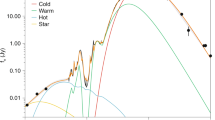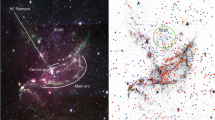Abstract
Optical surveys of the global star-formation rate in high-redshift galaxies show a strong peak in activity at a redshift of z ≈ 1.5, which implies that most of the star formation1 has already been seen. High-redshift galaxies may, however, emit most of their energy at submillimetre wavelengths, if they contain substantial amounts of dust that absorbs the starlight and reradiates it as far-infrared light. Here we report a deep survey of a blank region of sky, performed at submillimetre wavelengths (450 and 850 μm). We detect luminous sources in the 850-μm band which, if they have similar spectra to low-redshift ultraluminous infrared galaxies and are primarily powered by star formation, must each be converting more than 100 solar masses of gas per year into stars: this is larger than themaximum star-formation rates inferred for most optically selected galaxies2. The total amount of star formation at high redshifts is essentially fixed by the level of background light, but where the peak activity occurs at submillimetre wavelengths is not yet well established. However, the background light inferred from the sources that we have detected is already comparable to that from the optically selected sources. Establishing the main epoch of star formation will therefore require a combination of optical and submillimetre studies.
This is a preview of subscription content, access via your institution
Access options
Subscribe to this journal
Receive 51 print issues and online access
$199.00 per year
only $3.90 per issue
Buy this article
- Purchase on Springer Link
- Instant access to full article PDF
Prices may be subject to local taxes which are calculated during checkout


Similar content being viewed by others
References
Madau, P. et al. High-redshift galaxies in the Hubble Deep Field: colour selection and star formation history to z ∼ 4. Mon. Not. R. Astron. Soc. 283, 1388–1404 (1996).
Pettini, M. et al. The discovery of primeval galaxies and the epoch of galaxy formation. In Cosmic Origins: Evolution of Galaxies, Stars, Planets, and Life(eds Shull, J. M., Woodward, E. E. & Thronson, H. A.) Astron. Soc. Pacif.(in the press); also as preprint astro-ph/9708117 at 〈http://xxx.lnnl.gov〉 ((1998)).
Steidel, C. C., Giavalisco, M., Pettini, M., Dickinson, M. & Adelberger, K. L. Spectroscopic confirmation of a population of normal star-forming galaxies at redshifts z > 3. Astrophys. J. 462, L17–L21 (1996).
Cowie, L. L., Hu, E. M., Songaila, A. & Egami, E. The evolution of the distribution of star formation rates in galaxies. Astrophys. J. 481, L9–L14 (1997).
Cowie, L. L. & Hu, E. M. High- z Lyman-alpha emitters. I. a blank-field search for objects near redshift z = 3.4 in and around the Hubble Deep Field and the Hawaii Deep Field SSA22. Astron. J. 115, 1319–1328 (1998).
Hu, E. M., Cowie, L. L. & McMahon, R. G. The density of Lyman-alpha emitters at very high redshift. Astrophys. J.(in the press); also as preprint astro-ph/9803011 at 〈http://xxx.lanl.gov〉 ((1998)).
Heckman, T. M., Robert, C., Leitherer, C., Garnett, D. R. & van der Rydt, F. The ultraviolet spectroscopic properties of local starbursts: implications at high-redshift. Astrophys. J.(in the press); also as preprint astro-ph/9803185 at 〈http://xxx.lanl.gov〉 ((1998)).
Blain, A. W. & Longair, M. S. Submillimeter cosmology. Mon. Not. R. Astron. Soc. 264, 509–521 (1993).
Smail, I., Ivison, R. J. & Blain, A. W. Adeep submillimeter survey of lensing clusters: a new window on galaxy formation and evolution. Astrophys. J. 490, L5–L8 (1997).
Holland, W. S. et al. SCUBA — a submillimeter camera operating on the James Clerk Maxwell Telescope. In Advanced technology MMW, radio and terahertz telescopes.(ed. Phillips, T.) Proc. SPIE 3357, (in the press).
Ivison, R. J. et al. Ahyperluminous galaxy at z = 2.8 found in a deep submillimeter survey. Mon. Not. R. Astron. Soc.(in the press); also as preprint astro-ph/9712161 at 〈http://xxx.lanl.gov〉 ((1998)).
Blain, A. W., Ivison, R. J. & Smail, I. Observational limits to source confusion in the millimeter/submillimeter waveband. Mon. Not. R. Astron. Soc. 296, L29–L33 (1998).
Puget, J. L. et al. Tentative detection of a cosmic far infrared background with COBE. Astron. Astrophys. 308, L5–L8 (1996).
Burigana, C. et al. Constraints on the cosmic star formation history from the far-infrared background. Mon. Not. R. Astron. Soc. 287, L17–L20 (1997).
Fixsen, D. J., Dwek, E., Mather, J. C., Bennett, C. L. & Shafer, R. A. The spectrum of the extragalactic far infrared background from the COBE firas observations. Astrophys. J.(in the press); also as preprint astro-ph/9803021 at 〈http://xxx.lanl.gov〉 ((1998)).
Schlegel, D., Finkbeiner, D. P. & Davis, M. Maps of dust IR emission for use in estimation of reddening and CMBR foregrounds. Astrophys. J. 500, 525–553 (1998).
Hauser, M. G. et al. The COBE diffuse infrared background experiment search for the cosmic infrared background: I. limits and detections. Astrophys. J.(in the press); also as preprint astro-ph/9806167 at 〈http://xxx.lanl.gov〉 ((1998)).
Oke, J. B., et al. The Keck low-resolution imaging spectrometer. Publ. Astron. Soc. Pacif. 107, 375–385 (1995).
Sanders, D. B. & Mirabel, I. F. Luminous infrared galaxies. Annu. Rev. Astron. Astrophys. 34, 749–782 (1996).
Klaas, U., Ilaas, M., Heinrichsen, I. & Schulz, B. Infrared spectral energy distributions of the interacting galaxies Arp 244, NGC 6240, and Arp 220. Astron. Astrophys. 325, L21–L24 (1997).
Scoville, N. Z. & Young, J. S. The molecular gas distribution in M51. Astrophys. J. 265, 148–165 (1983).
Thronson, H. & Telesco, C. Star formation in active dwarf galaxies. Astrophys. J. 311, 98–112 (1986).
Cimatti, A., Andreani, P., Röttgering, H. & Tilanus, R. Vigorous star formation hidden by dust in a galaxy at z = 1.4. Nature 392, 895–896 (1998).
Songaila, A., Cowie, L. L. & Lilly, S. J. Galaxy formation and the origin of the ionizing flux at large redshift. Astrophys. J. 348, 371–377 (1990).
Blain, A. W., Smail, I., Ivison, R. J. & Kneib, J.-P. The history of star formation in dusty galaxies. Mon. Not. R. Astron. Soc.(submitted); also as preprint astro-ph 9806062 at 〈http://xxx.lanl.gov〉 ((1998)).
Jenness, T. SURF — SCUBA User Reduction Facility(Starlink User Note no. 216.1, J.A.C., Hilo, (1997)).
Hodapp, K.-W. et al. The HAWAII infrared detector arrays: testing and astronomical characterization of prototype and science-grade devices. New Astron. 1, 177–196 (1996).
Matthews, K. & Soifer, B. T. in Infrared Astronomy with Arrays: the Next Generation(ed. McLean, I.) 239–246 (Kluwer, Dordrecht, (1994)).
Taniguchi, Y. et al. ISOCAM 7 micron deep survey of the Lockman hole: A mid-infrared search for primeval galaxies. Astron. Astrophys. 328, L9–L12 (1997).
Acknowledgements
We thank R. Tilanus, T. Jenness, I. Smail and W. Vacca for discussions.
Author information
Authors and Affiliations
Corresponding author
Additional information
ISO Science Operations Centre, Astrophysics Division of ESA, Villafranca, E-28080, Madrid, Spain
Rights and permissions
About this article
Cite this article
Barger, A., Cowie, L., Sanders, D. et al. Submillimetre-wavelength detection of dusty star-forming galaxies at high redshift. Nature 394, 248–251 (1998). https://doi.org/10.1038/28338
Received:
Accepted:
Issue Date:
DOI: https://doi.org/10.1038/28338
This article is cited by
-
Star formation and nuclear activity in luminous infrared galaxies: an infrared through radio review
The Astronomy and Astrophysics Review (2021)
-
The gravitationally unstable gas disk of a starburst galaxy 12 billion years ago
Nature (2018)
-
The star-forming complex LMC-N79 as a future rival to 30 Doradus
Nature Astronomy (2017)
-
A cosmic growth spurt in an infant galaxy
Nature (2013)
-
The rapid assembly of an elliptical galaxy of 400 billion solar masses at a redshift of 2.3
Nature (2013)
Comments
By submitting a comment you agree to abide by our Terms and Community Guidelines. If you find something abusive or that does not comply with our terms or guidelines please flag it as inappropriate.



